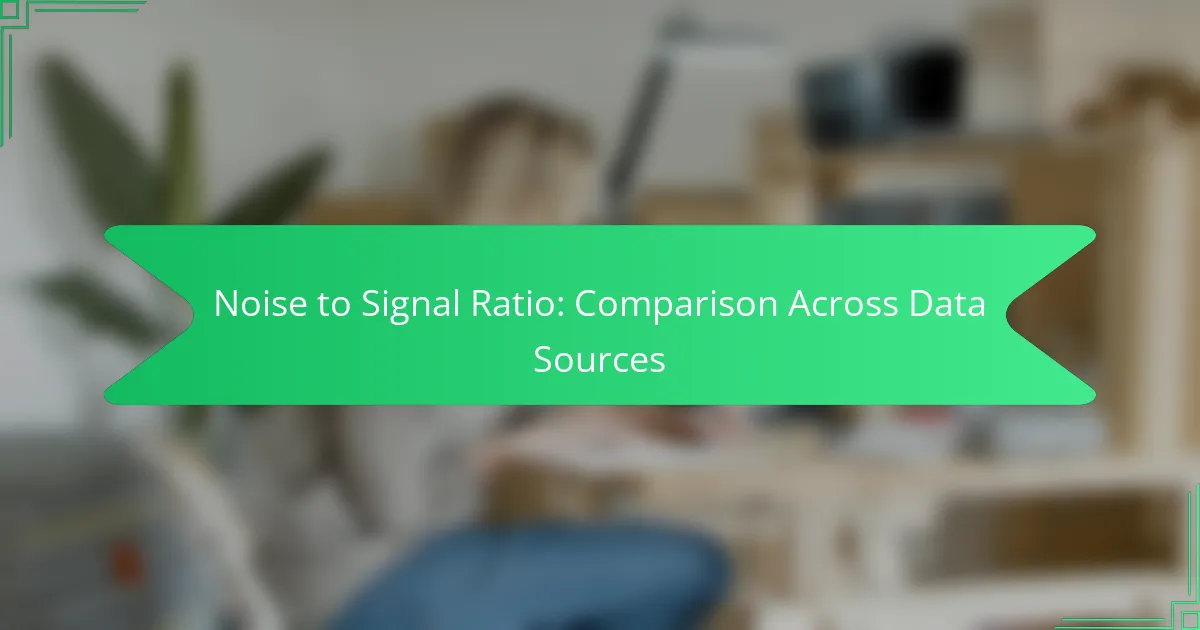The noise to signal ratio (NSR) is a critical metric in data analysis that highlights the quality of information derived from various data sources. By understanding the differences in NSR across these sources, analysts can make informed decisions about which data to utilize, ultimately enhancing the clarity and relevance of their findings.

What are the best practices for improving noise to signal ratio in data analysis?
Improving the noise to signal ratio in data analysis involves implementing strategies that enhance the clarity of the data while minimizing irrelevant information. Key practices include filtering data, applying statistical methods, leveraging machine learning, monitoring data in real-time, and integrating domain-specific knowledge.
Data filtering techniques
Data filtering techniques are essential for removing unwanted noise from datasets. Common methods include removing outliers, applying thresholding, and using moving averages to smooth data. For instance, in time-series data, a moving average can help clarify trends by reducing short-term fluctuations.
Another effective approach is to use filters like Kalman or Butterworth filters, which can help isolate the signal from noise in various applications. These techniques can significantly enhance the quality of the data being analyzed.
Statistical methods for noise reduction
Statistical methods play a crucial role in reducing noise in data analysis. Techniques such as regression analysis can help identify and remove noise by modeling the underlying relationships in the data. For example, using linear regression can help predict outcomes while filtering out random noise.
Additionally, techniques like principal component analysis (PCA) can reduce dimensionality and highlight significant patterns, effectively minimizing noise. Employing these methods can lead to more accurate insights from the data.
Utilizing machine learning algorithms
Machine learning algorithms can enhance the noise to signal ratio by learning from data patterns and filtering out noise. Supervised learning models, such as decision trees or support vector machines, can be trained to distinguish between relevant signals and noise.
Unsupervised learning techniques, like clustering, can also help identify and group similar data points, which may reveal underlying signals while discarding noise. Implementing these algorithms requires careful tuning to optimize performance and accuracy.
Implementing real-time data monitoring
Real-time data monitoring is vital for maintaining a high noise to signal ratio. By continuously analyzing incoming data streams, organizations can quickly identify and address noise as it occurs. This proactive approach allows for immediate adjustments and enhances data quality.
Setting up alerts for anomalies or unexpected patterns can help teams respond promptly to noise issues. Regularly reviewing and adjusting monitoring parameters ensures that the system remains effective in filtering out irrelevant information.
Integrating domain-specific knowledge
Integrating domain-specific knowledge is crucial for improving the noise to signal ratio. Understanding the context of the data allows analysts to identify what constitutes noise versus meaningful signals. For example, in financial markets, knowledge of economic indicators can help filter out irrelevant fluctuations.
Collaboration with subject matter experts can provide insights that enhance data interpretation and signal identification. This integration ensures that analysis is grounded in relevant context, leading to more accurate conclusions.

How does noise to signal ratio vary across different data sources?
The noise to signal ratio (NSR) differs significantly across various data sources, affecting data quality and analysis outcomes. Understanding these variations helps in selecting the right data source for specific analytical needs.
Social media data
Social media data typically has a high noise to signal ratio due to the vast amount of unfiltered content generated by users. This includes irrelevant posts, spam, and misinformation, which can obscure valuable insights.
To mitigate noise, analysts often employ sentiment analysis and natural language processing techniques to extract meaningful signals. Focusing on specific hashtags or keywords can also help refine the data set.
Sensor data
Sensor data generally exhibits a lower noise to signal ratio, as it is often generated from controlled environments and calibrated devices. However, environmental factors, such as temperature fluctuations or interference, can introduce noise.
Regular calibration and maintenance of sensors are crucial to ensure data accuracy. Implementing filtering algorithms can further enhance the signal quality by removing outliers and irrelevant readings.
Financial market data
Financial market data can have a moderate to high noise to signal ratio, influenced by market volatility and external events. Rapid price fluctuations and speculative trading can create misleading signals.
Traders often use technical indicators and statistical models to filter out noise and identify genuine trends. Understanding market conditions and timing is essential for effective analysis.
Survey data
Survey data typically has a low noise to signal ratio if designed properly, but biases and poorly formulated questions can introduce noise. Respondent honesty and understanding of questions also play a critical role in data quality.
To minimize noise, ensure questions are clear and unbiased, and consider using a diverse sample size. Analyzing demographic data can help identify and correct for potential biases in responses.

What tools can help analyze noise to signal ratio?
Several tools can effectively analyze noise to signal ratio, offering various functionalities for data manipulation and visualization. These tools range from programming libraries to dedicated visualization software, each providing unique advantages for assessing data quality.
Python libraries (e.g., NumPy, Pandas)
Python libraries such as NumPy and Pandas are essential for analyzing noise to signal ratio in datasets. NumPy provides powerful numerical operations, allowing users to perform calculations on arrays efficiently, while Pandas offers data manipulation capabilities that make it easy to clean and preprocess data.
To analyze noise to signal ratio, you can calculate the standard deviation of noise and the mean of the signal using these libraries. For instance, if you have a dataset with a known signal and background noise, you can use Pandas to filter and aggregate the data before applying NumPy functions to derive the ratio.
R packages (e.g., dplyr, ggplot2)
R packages like dplyr and ggplot2 are excellent for statistical analysis and visualization of noise to signal ratio. dplyr simplifies data manipulation with functions that allow for easy filtering, summarizing, and grouping of data, while ggplot2 excels in creating informative visualizations.
In practice, you can use dplyr to preprocess your data, calculating the mean and standard deviation, and then visualize the results with ggplot2. This approach helps in identifying patterns and assessing the quality of the signal amidst noise.
Data visualization tools (e.g., Tableau, Power BI)
Data visualization tools such as Tableau and Power BI are valuable for presenting noise to signal ratio analysis in a user-friendly format. These platforms enable users to create interactive dashboards that highlight key metrics and trends in the data.
When using these tools, you can import your cleaned data and utilize built-in functions to calculate and visualize the noise to signal ratio. For example, you can create scatter plots or bar charts that clearly depict the relationship between signal strength and noise levels, making it easier to communicate findings to stakeholders.

What criteria should be used to select data sources for analysis?
Selecting data sources for analysis requires careful consideration of reliability, relevance, and timeliness. These criteria ensure that the data used will provide accurate insights and support the research objectives effectively.
Data reliability and accuracy
Data reliability refers to the consistency of data over time, while accuracy indicates how closely the data reflects the true values. When evaluating sources, prioritize those with established methodologies, peer-reviewed processes, or recognized standards. For instance, data from government agencies or reputable research institutions often meets high reliability and accuracy standards.
Common pitfalls include relying on unverified sources or anecdotal evidence, which can lead to skewed results. Always cross-check data against multiple sources to ensure its credibility.
Relevance to research objectives
Data relevance is about how well the information aligns with your specific research questions or objectives. Selecting data that directly addresses your needs will enhance the quality of your analysis. For example, if researching consumer behavior in the European market, focus on data sources that provide insights specific to that demographic.
To assess relevance, consider the context of the data and its intended use. Avoid sources that, while interesting, do not contribute directly to your research goals.
Timeliness of data
Timeliness refers to how current the data is and its suitability for the analysis at hand. Outdated data can lead to incorrect conclusions, especially in fast-changing fields like technology or finance. Aim for data that is updated regularly or has a clear timestamp indicating its currency.
When selecting data sources, check the publication dates and frequency of updates. For instance, financial data should ideally be no older than a few months to remain relevant. Using a mix of historical and current data can provide a more comprehensive view, but prioritize recent data for immediate analysis.

How can businesses leverage noise to signal ratio for competitive advantage?
Businesses can leverage the noise to signal ratio by identifying and minimizing irrelevant data while maximizing valuable insights. This approach allows companies to make informed decisions, enhance customer understanding, and refine marketing efforts, ultimately leading to a stronger competitive position.
Enhancing decision-making processes
To enhance decision-making, businesses should focus on filtering out noise from their data sources. This involves using analytical tools to prioritize high-quality data that directly impacts business outcomes. For example, companies can implement data visualization techniques to highlight key performance indicators, making it easier to spot trends and anomalies.
Regularly reviewing data sources and their relevance is crucial. Establishing a feedback loop where decision-makers assess the effectiveness of their data can help refine the noise to signal ratio over time.
Improving customer insights
Improving customer insights requires businesses to analyze customer data while minimizing irrelevant information. By segmenting customers based on behavior and preferences, companies can focus on the most relevant signals that indicate customer needs and desires. This targeted approach allows for more personalized interactions, enhancing customer satisfaction.
Utilizing tools like customer relationship management (CRM) systems can help aggregate and analyze customer data effectively. Regularly updating these systems ensures that businesses have access to the latest insights, which can inform product development and service enhancements.
Optimizing marketing strategies
To optimize marketing strategies, businesses must understand the noise to signal ratio in their marketing data. This involves analyzing campaign performance metrics to identify which channels and messages resonate most with target audiences. By focusing on high-performing signals, companies can allocate resources more effectively.
Testing and iterating marketing campaigns based on data-driven insights is essential. For instance, A/B testing different ad creatives can reveal which versions yield better engagement, allowing businesses to refine their strategies and improve return on investment (ROI).










